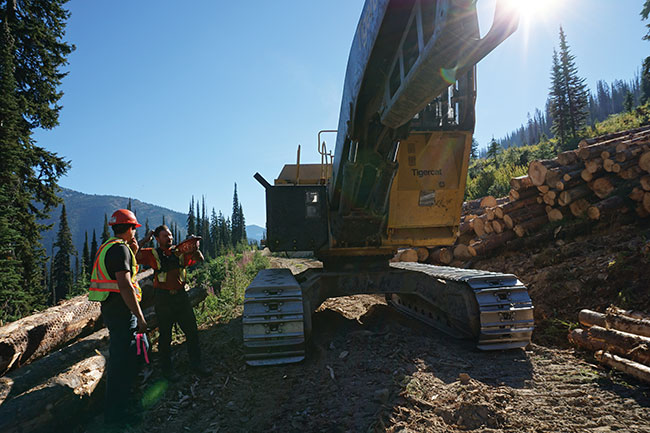
Features
Logging Profiles
Steeped in pride: Steep slope contractor fronts Logger Pride movement
December 22, 2022 By Jennifer Ellson
 Pride in the job: from humble beginnings to starting a movement that promotes the trade.
Pride in the job: from humble beginnings to starting a movement that promotes the trade. A logging business started by the husband-and-wife team of Al and Erin Fitchett more than two decades ago has grown not only in size and profitability, but also in community involvement, even starting a movement promoting the trade.
Humble beginnings
A.F. Timber began operations in 1998 as a modest one-machine operation in Nelson, B.C., when Al bought a used Cat D4 Hi-drive crawler with a winch on the back. Barely 22 years old then, he hired a co-worker to fall trees in the morning and skid them out in the afternoon, while his wife Erin took charge of the administrative duties.
As the operations grew, Al bought a Thunderbird TMY40 yarder to take advantage of the abundance of steeply forested slopes in local mountains.
Today, the company boasts a fleet of gear that makes it a full phase stump-to-dump logging company, supplying forest products to various markets in British Columbia’s Kootenay region.
The contractor supplies fir, larch, hemlock, spruce and pine sawlog to Kalesnikoff Lumber in Thrums, B.C. It also supplies the neighbouring Castlegar-based Mercer Celgar with pulp, and cedar sawlog to Porcupine Wood Products in Salmo, B.C.

Al and Erin Fitchett, the husband-and-wife team operating a logging business and handing out bursaries to young forestry students. (Erin’s photo courtesy of Fitchett family.)
Thriving and expanding
The contractor’s expanding equipment inventory comprises a Cat 535C grapple skidder, a Diamond 210 yarder with Alpine grapple carriage and ACME slack puller carriage, a Hyundai 3026 excavator with bucket and Weldco-Beales power clam, a Hyundai 250 log loader with live heel, a Hyundai 250 back spar, and a Western Star tri drive with Anser wagon, convertible to be used for either short or long logs. The contractor hires additional trucks as needed. Other machineries include a Tigercat 875 log loader with 605 Southstar grapple processor, a Tigercat 855D buncher and a Tigercat 855C tilter hoe chucker with IMAC power clam.
While specializing in steep slope logging, A.F. Timber also has road building and conventional logging expertise.
“We’ve been logging steep side hills for 20 years. It’s what we know and what we do well,” says Erin, who is the operations manager. “We started conventional ground-based harvesting in the beginning, but quickly within a few years we have seen the need and opportunity for steep slope cable harvesting.”
“The Tigercat tilter hoe chucker is a great tool for us. It allows us to feed to skyline of the yarder in many settings. The Tigercat 875 log loader with Southstar grapple processor is used to process logs and load trucks from the rear. On almost all our cable settings, there’s only a road width for a landing so you cannot load from the side,” explains Al.
A slope is considered steep when it reaches a grade of 35 per cent, or about 25 degrees – the steepness of an advanced ski run. Indeed, the region’s steep terrain is known for its world-class downhill and snowcat skiing.
In September, Canadian Forest Industries joined A.F. Timber’s crew led by Al and his lead foreman Jake Velisek on a block near Nelson to get a better look at cable yarding the steep, difficult terrain of the province’s West Kootenay region.
A.F. Timber harvests a diversity of species – fir, cedar, pine, larch, hemlock, spruce – commonly called the “Kootenay mix”. It harvests around 45,000 cubic metres a year via cable, full tree to roadside, and some 20,000 cubic metres a year of sawlog via conventional logging, averaging around 22 inches in diameter.
“We cut long logs for the most part, only cutting shorts in small diameter pulp situations,” Al says of the work done by the seven-person team working 45 hours of day shifts per week.
The average yarding and skidding distances are not much more than 350 metres, and the average haul distance to the mill is usually less than 60 kilometres.
Steep challenges
Logging on steep slopes means facing the associated challenges that are sometimes as steep as the hills being logged.
Access to fibre is a huge challenge. “We have tailored our business to suit the needs of our clients in the Kootenays. Kalesnikoff’s approach to doing more with less volume is a perfect fit for our business,” Al explains. “Opportunities for us are definitely focused on harvesting challenging terrain and higher value products, not increasing volume.”
Another significant challenge is dealing with the region’s geography and topography: the Kootenays have a lot of rock and tracked machines on rock is difficult to manage. Focus is on safety, as operating a safe work environment is an everyday priority, naturally.
Logger Pride movement
That’s part of the reasoning behind the Logger Pride movement – a system of values taught by doing a dangerous job to a high degree of skill while being part of a smoothly functioning team in mostly adverse conditions. It’s being proud of what you do and knowing that you have made an achievement, then taking that feeling of accomplishment to inspire you to do good. The Fitchetts are passionate about the movement, which includes promoting the trade. They have worked with Selkirk College in developing a logging training program. The Fitchetts are also generously giving back to the community by sponsoring an annual bursary of $1,500 for young people entering the forest industry at any Canadian post-secondary institution. Since 2016, A.F. Timber has invested in eight students and this year, two bursaries were awarded to two young students.
Erin regularly speaks to fifth grade students during Forestry Week on how logging is sustainable and beneficial to the community. This year she spoke to over 200 young students.
“They’re very curious and they have genuinely good questions about our industry,” says Erin. “I ask them questions like, ‘why do you think we harvest timber?’ It’s really interesting to hear their ideas about logging. I challenge them to count how many times they touch wood in a day, because it’s in so many of the products we use daily. Then, we talk about how it’s a renewable resource and how we harvest it.”
Print this page